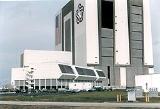
Launch Control Center
Encyclopedia
The Launch Control Center (LCC) is a four-story building located at NASA
's Kennedy Space Center
on Merritt Island, Florida
used for the supervision of launches from Launch Complex 39
. In practice, this means that the LCC handles all American manned space flights. Attached to the southeast corner of the Vehicle Assembly Building
, the LCC contains offices; telemetry, tracking and instrumentation equipment; the automated Launch Processing System
; and four firing rooms.
Launches have been conducted from the LCC since the unmanned Apollo 4
(Apollo-Saturn 501) launch on November 9, 1967; its first manned launch was Apollo 8
on December 21, 1968.


 Launch operations are supervised and controlled from the firing room. Responsibility for the booster and spacecraft remains with the LCC until the booster has cleared the launch tower, when responsibility is handed over to the Mission Control Center
Launch operations are supervised and controlled from the firing room. Responsibility for the booster and spacecraft remains with the LCC until the booster has cleared the launch tower, when responsibility is handed over to the Mission Control Center
at Johnson Space Center.
Extensive renovation of Firing Room 4 was finished in 2006.
NASA
The National Aeronautics and Space Administration is the agency of the United States government that is responsible for the nation's civilian space program and for aeronautics and aerospace research...
's Kennedy Space Center
Kennedy Space Center
The John F. Kennedy Space Center is the NASA installation that has been the launch site for every United States human space flight since 1968. Although such flights are currently on hiatus, KSC continues to manage and operate unmanned rocket launch facilities for America's civilian space program...
on Merritt Island, Florida
Merritt Island, Florida
Merritt Island is a census-designated place in Brevard County, Florida, United States. It is located on the east coast of the state on the Atlantic Ocean. As of the 2000 census, the population was 36,090. It is part of the Palm Bay – Melbourne – Titusville, Florida Metropolitan Statistical Area...
used for the supervision of launches from Launch Complex 39
Kennedy Space Center Launch Complex 39
Launch Complex 39 is a rocket launch site at the John F. Kennedy Space Center on Merritt Island in Florida, USA. The site and its collection of facilities were originally built for the Apollo program, and later modified to support Space Shuttle operations. NASA began modifying LC-39 in 2007 to...
. In practice, this means that the LCC handles all American manned space flights. Attached to the southeast corner of the Vehicle Assembly Building
Vehicle Assembly Building
The Vehicle Assembly Building, or VAB, at NASA's Kennedy Space Center was used to assemble and house American manned launch vehicles from 1968-2011. It is the fourth largest building in the world by volume...
, the LCC contains offices; telemetry, tracking and instrumentation equipment; the automated Launch Processing System
Launch Processing System
The Launch Processing System is an automated, computer-controlled system at the Kennedy Space Center which oversees and coordinates the processing and checkout of systems and components for the Space Shuttle launch vehicle and its payloads...
; and four firing rooms.
Launches have been conducted from the LCC since the unmanned Apollo 4
Apollo 4
Apollo 4, , was the first unmanned test flight of the Saturn V launch vehicle, which was ultimately used by the Apollo program to send the first men to the Moon...
(Apollo-Saturn 501) launch on November 9, 1967; its first manned launch was Apollo 8
Apollo 8
Apollo 8, the second manned mission in the American Apollo space program, was the first human spaceflight to leave Earth orbit; the first to be captured by and escape from the gravitational field of another celestial body; and the first crewed voyage to return to Earth from another celestial...
on December 21, 1968.
Firing room



Mission Control Center
A mission control center is an entity that manages aerospace vehicle flights, usually from the point of lift-off until the landing or the end of the mission. A staff of flight controllers and other support personnel monitor all aspects of the mission using telemetry, and send commands to the...
at Johnson Space Center.
Extensive renovation of Firing Room 4 was finished in 2006.

